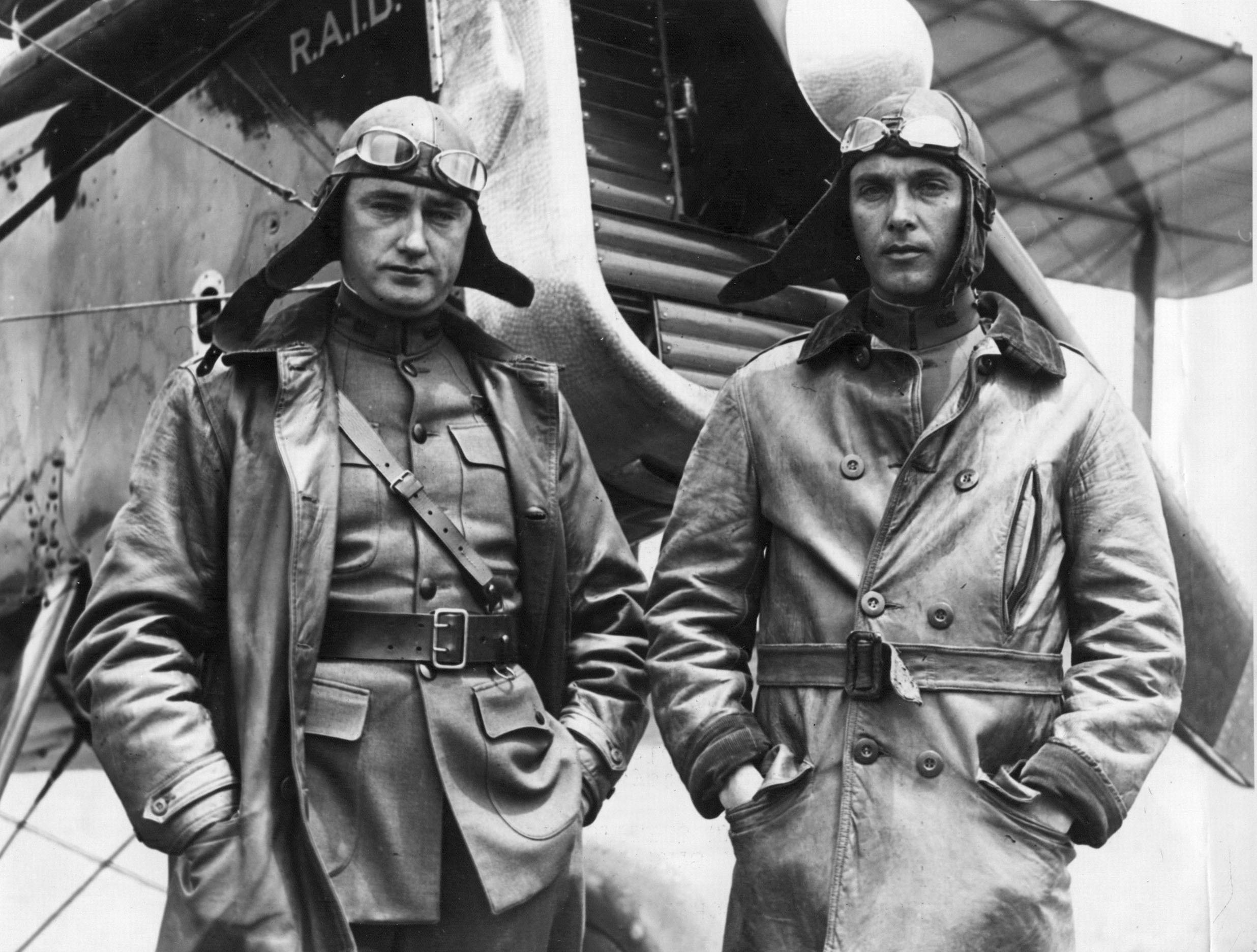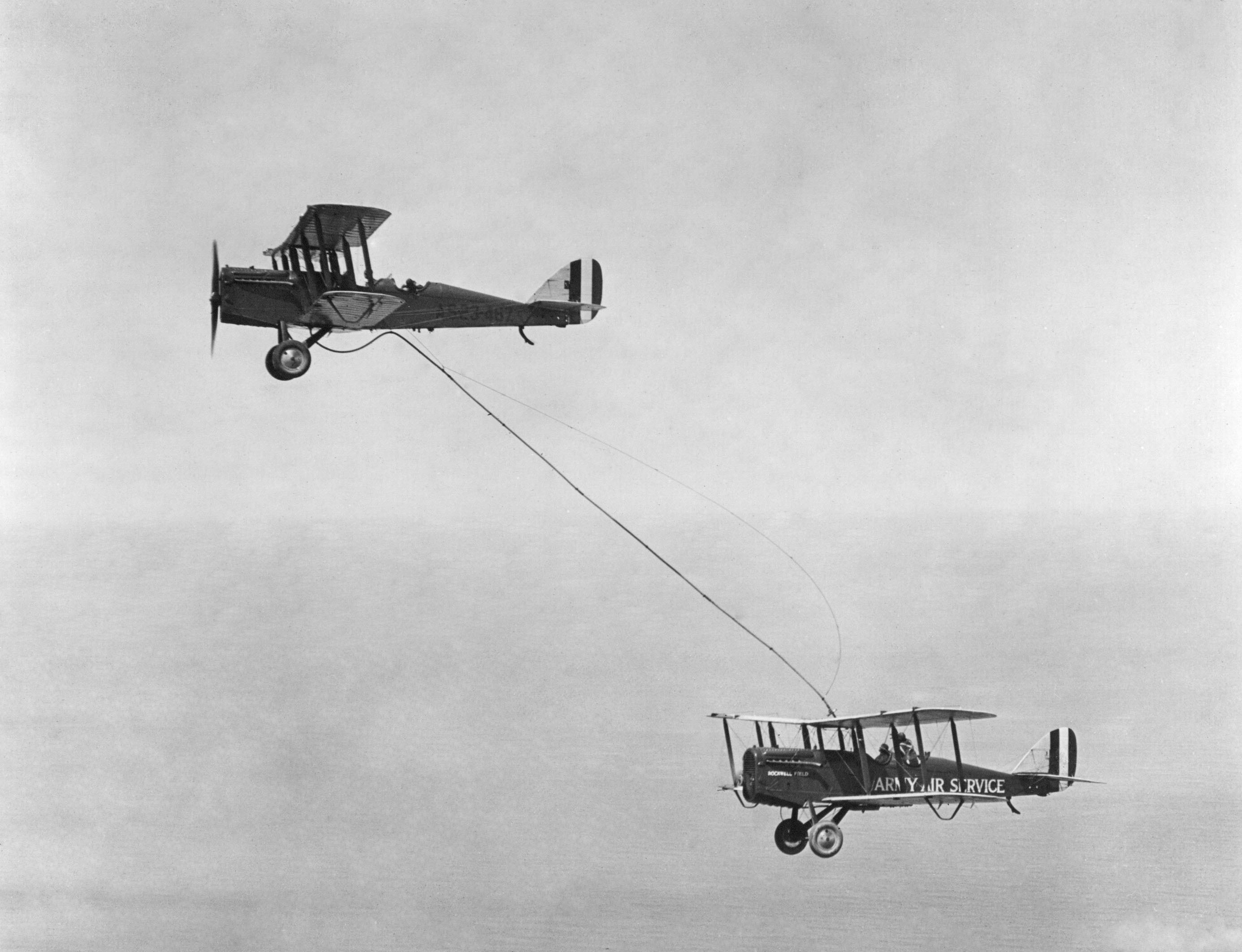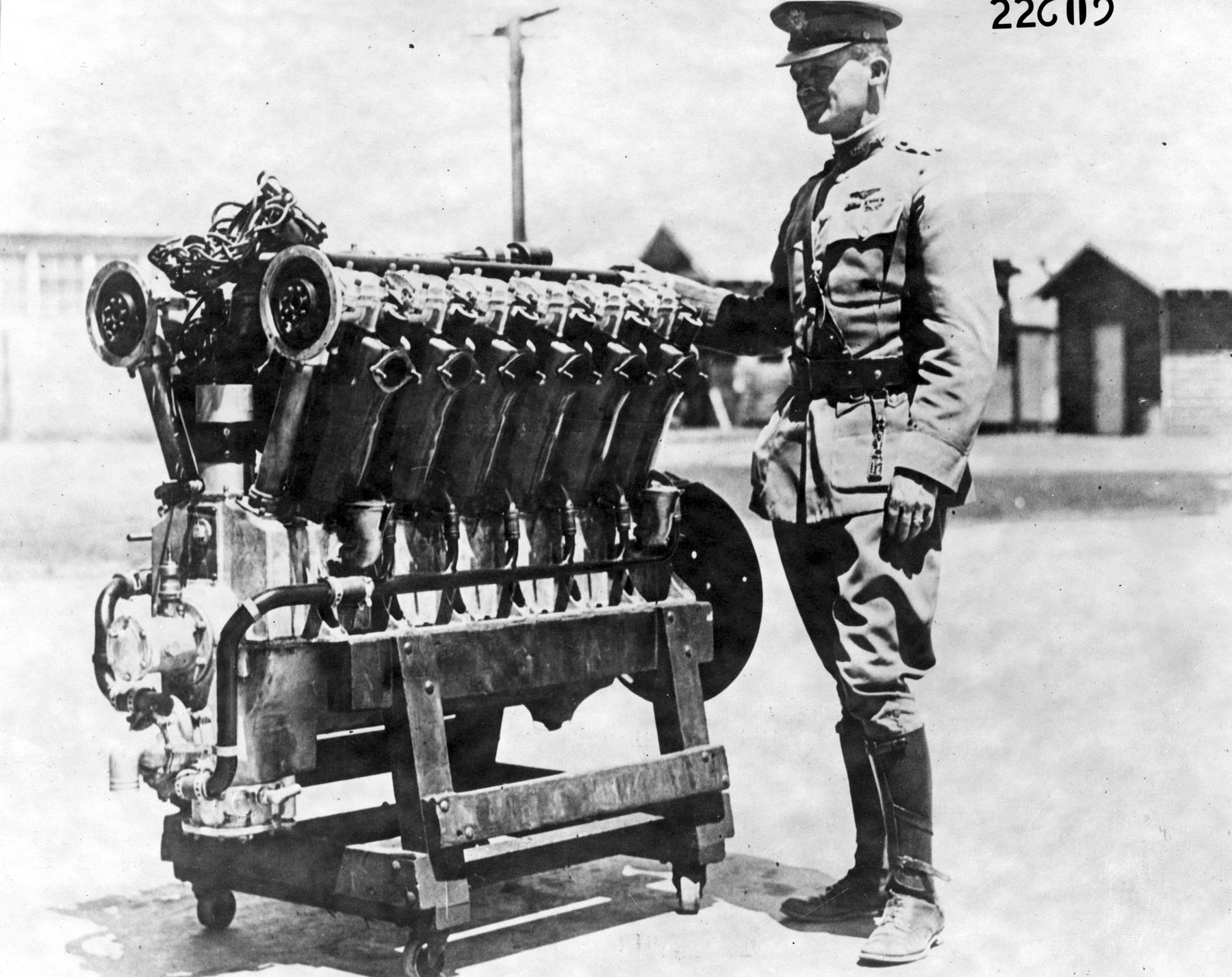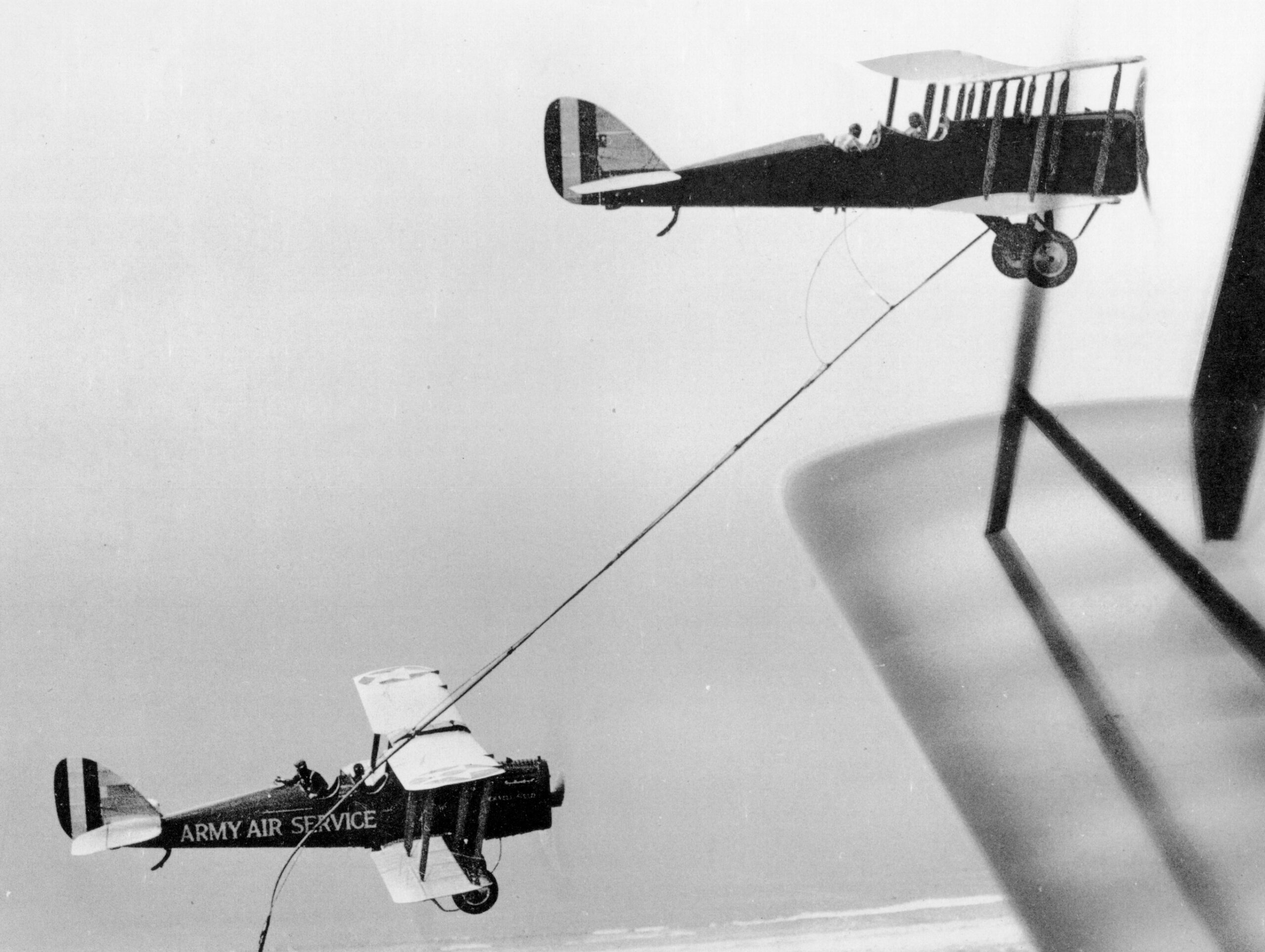
The first successful aerial refueling took place on June 27, 1923, when a DH-4B, Air Service serial number A.S. 23-462, carrying Lieutenants Virgil S. Hine and Frank Walter Seifert passed gasoline through a hose to another DH-4B which was flying beneath them carrying Lieutenants Lowell Herbert Smith and John Paul Richter.
Hine and Smith piloted their respective airplanes while Seifert and Richter handled the refueling. A 50 foot (15.24 meter) hose with manually-operated quick-acting valves at each end was used. During the refueling, 75 gallons (284 liters) of gasoline was passed from the tanker to the receiver.
Smith and Richter landed after 6 hours, 38 minutes, when their airplane developed engine trouble. Only one refueling had been completed but that had demonstrated the feasibility of the procedure.

For their accomplishment, all four officers were awarded the Distinguished Flying Cross.
The United Press reported:
AVIATORS GOING AFTER ENDURANCE RECORD FORCED TO COME DOWN
Burned-out Generator Puts End to Non-Stop Flight
BEEN FLYING FIVE AND HALF HOURS
Plan to Make Another Start Tomorrow In Same Plane
[UNITED PRESS LEASED WIRE]
SAN DIEGO, Cal., June 27.—A burned-out generator on the non-stop DeHavilland plane piloted by Captain Lowell H. Smith and Lieutenant John B. Richter forced the airmen down at 10:20 a.m. today, after they had been in the air for five hours and 36 minutes and had successfully taken on fuel while in flight.
Another start will be made tomorrow morning at the same time, with the same plane.
The endurance plane was successfully refueled at 10 a.m. by Lieutenants Virgil Hines and Frank Seifert, flying in another plane. The 100 gallons of gasoline was dropped through a 40-foot rubber hose while the two planes speeded at a rate of 90 miles an hour, The transfer was made in a minute and a half, while the planes traveled over the marine base at Rockwell Field. Oil and messages were also transferred successfully and the plane continued on toward the Tia Juana end of the course, while the fueling plane alighted at North Island.
Danger of Explosion
Had the slightest mishap occurred both planes risked destruction in flames. The gas passed within a few inches of hot exhaust pipes from the engines of the De Havilland plane.
“It was necessary to make two contacts between the planes,” said Lieutenant Seifert, when the fueling plane landed.
“We gave them 40 gallons the first time. The second time we got about 50 gallons to them.”
Captain Smith and Lieutenant Richter hopped off at Rockwell Field at 4:43:43 3-5 a.m. in their attempt to remain in the air four days without stopping.
In addition to the aviation time record, the aviators hoped to break speed records for 2,000, 2,500, 3,000 and 4,000 kilometers.
Bothered by Fog
The men took off in a fog which bothered them from the start.
“We are forced to fly at an altitude of 100 feet because of the fog,” they wirelessed at 7:05 a.m.
This flying over the city is extremely dangerous. Their first thought was of the citizens of San Diego they awakened, and this was their message to the United Press:
“We are sorry to have to disturb the residents at such an hour. Everything is going fine.”
The men wore parachutes buckled on ready for any emergency. Lieutenant Hynes and Frank Seifert, in the refueling plane were equipped in the same fashion.
Carried No Food
They carried a light supply of gasoline and oil, in order to make speed, and a thermos bottle of coffee and hot water. No food was carried. A complete meal, with a menu prepared by North Island chefs, was to be dropped to the aviators from another plane three times a day. The aviators planed to take turns at the stick, one eating and sleeping while the other piloted the plane Neither expected to get much sleep during the four days. At 8 a.m. the plane had averaged about 70 miles an hour.
Rigid air rules were enforced to protect the birdmen on their history-making flight, all other planes in this vicinity being instructed to keep several thousand yards away from the course.
—Hollywood Daily Citizen, Vol. 19, No. 75, Wednesday, 27 June 1923, Page 1, Columns 6–8, and Page 2, Column 6
The following year, Lieutenant Smith piloted the Douglas World Cruiser Chicago on its around-the-world flight.
The Airco DH.4 was a very successful airplane of World War I, designed by Geoffrey de Havilland. It was built by several manufacturers in Europe and the United States. The DH-4B was a rebuilt DH.4 with fuel capacity increased to 110 gallons (420 liters). The DH-4B was 30 feet, 6 inches (9.296 meters) long with a wingspan of 43 feet, 6 inches (13.259 meters) and height of 10 feet, 4 inches (3.150 meters). Loaded weight of the standard DH-4B was 3,557 pounds (1,613.4 kilograms).
In place of the Rolls-Royce Eagle VII V-12 of the British-built version, Army Air Service DH-4s were powered by a water-cooled, normally-aspirated, 1,649.336-cubic-inch-displacement (27.028 liter) Liberty L-12 single overhead cam (SOHC) 45° V-12 engine with a compression ratio of 5.4:1. The Liberty produced 408 horsepower at 1,800 r.p.m. The L-12 as a right-hand tractor, direct-drive engine. It turned turned a two-bladed fixed-pitch wooden propeller. The Liberty 12 was 5 feet, 7.375 inches (1.711 meters) long, 2 feet, 3.0 inches (0.686 meters) wide, and 3 feet, 5.5 inches (1.054 meters) high. It weighed 844 pounds (383 kilograms).

The Liberty L12 aircraft engine was designed by Jesse G. Vincent of the Packard Motor Car Company and Elbert J. Hall of the Hall-Scott Motor Company. This engine was produced by Ford Motor Company, as well as the Buick and Cadillac Divisions of General Motors, The Lincoln Motor Company (which was formed by Henry Leland, the former manager of Cadillac, specifically to manufacture these aircraft engines), Marmon Motor Car Company and Packard. Hall-Scott was too small to produce engines in the numbers required.
The DH-4B had a maximum speed of 128 miles per hour (206 kilometers per hour), service ceiling of 19,600 feet (5,974 meters) and range of 400 miles (644 kilometers).

© 2017, Bryan R. Swopes
Your photo of the Spirit of St. Louis reported as having been taken on May 11, 1927 was not taken on that day. It was taken after Lindbergh’s return to the US, his tour around the US and his triumphant return to St. Louis after his successful Goodwill tour of South America and the Caribbean. This can be ascertained by details in the aforementioned photo. Please note the pointed spinner which was a replacement for the original spinner installed in San Diego. The original spinner was found to be cracked upon Lindbergh’s arrival in New York after his stopover in St. Louis on his way east. You will also note the small flags painted on the side engine cowling which were added as he visited the various countries he visited in Central America, South America and the Caribbean. You will also note the carburetor air heater at the bottom of the engine which was installed in New York prior to the Atlantic flight but after Lindbergh’s stop in St. Louis. You will also note the larger 30×5 wheels and tires which were installed during Lindbergh’s Guggenheim sponsored tour of the US after Lindbergh’s return to the US after his Atlantic crossing.
Respectfully
Ty N. Sundstrom
Thank you, Mr. Sundstrom. You have a great eye for detail. I will correct the caption. And thank you for visiting my blog.
Bryan
Congratulations on a most exceptional and interesting blog that supports learning the history of aviation.
Thank you very much, Desmond. 🙂
Lieutenant Lowell H. Smith: Besides being the first to “pass gas in an airplane,” was he the same Lowell Smith that flew for Pancho Villa, dropped the first bomb from an airplane, and flew one of the Douglas World Cruisers on the 1924 circumnavigation flight? If the same guy, what a colorful character. I really enjoy your presentations, Bryan.
Thank you very much, Hugh.